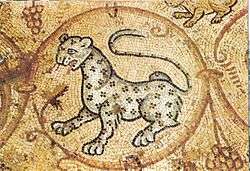Maon Synagogue
 Maon synagogue mosaic floor | |
 Shown within Israel | |
| Coordinates | 31°20′06″N 34°23′45″E / 31.3349°N 34.395897°E |
|---|---|
The Maon Synagogue is a 6th-century synagogue and archaeological site located in the Negev Desert near Kibbutz Nirim and Kibbutz Nir Oz. It is noted for its "magnificent" mosaic floor.[1]
Archaeological finds

The original date of the synagogue is uncertain but is before the 6th century. In a sixth-century renovation, the northern wall (closest to Jerusalem) was opened and a semi-circular apse to contain a Torah Ark was constructed. The floor level was raised and marble columns and a "breathtakingly beautiful" mosaic floor installed.[2]
At the bottom of the mosaic floor is an amphora flanked by a pair of peacocks. A vine flows out of the amphora, forming loops, in each loop is a bird, animal, fruit, or a depiction of steps in the wine making process. The design is so similar to the mosaics in the church floor at nearby Shallal that they are thought to have been designed by the same artist. Both floors depict animals and have similar patterns: the synagogue floor is distinguished by a menorah flanked by two lions and several other Jewish ritual objects. The seven-branched menorah stands on three legs, like the menorah in the Temple in Jerusalem. The legs in Maon are shaped like a lion's paws. Alongside the menorah are the symbols of Judah, palm trees and lions. Esrogs, a shofar and a lulav are depicted nearby. The Mosaic has an inscription in Aramaic. The upper part of the inscription blesses all members of the community, the lower part honors three donors.[1][2][3] An identical floor was found in the ancient synagogue in Gaza.[2]
The synagogue is built on the basilica plan. The mosaic is in the central area, the two side aisles were paved with stone. The ceiling was made of wooden beams and clay.[2]
A number of small objects were found by the salvage dig on the floor facing the Torah Ark. These include coins and bone and metal artifacts that are thought to have been associated with the Torah Ark and its ornamental curtain. There were also fragments of glass and ceramic lamps. Dozens of amulets were also found, some of them were used by women who were asking for good health.[2]
Adjacent to the ruins of the synagogue a cistern, water channels and a mikvah.[1]
History
The synagogue was built at the site of Hellenistic Menois, a city marked on the Map of Madaba. It is one of three ancient synagogues discovered in the western Negev.[2]
The synagogue and its mosaic floor were discovered during the construction of a road in 1957. The mosaic was damaged, but the undamaged segment was preserved by a salvage excavation. After its discovery, the mosaic was neglected, causing deterioration. Restoration work began in 2006, sponsored by the Jewish National Fund, Israel Antiquities Authority and Eshkol Regional Council, and paid for by philanthropist Sandy Galet. The mosaic was lifted off its original foundation and carefully cleaned. A new foundation was installed and the mosaic was securely attached. The mosaic is now protected and was opened to the public in 2009.[4][5]
See also
References
- 1 2 3 "Mamshit & the Ancient Synagogue of Maon, Jacqueline Schaalje, Jewish Magazine.
- 1 2 3 4 5 6 "One of the Most Spectacular Mosaic Floors Ever Discovered in Israel was Restored and Renovated and Can Now be Seen by the General Public," (30/3/09), Israel Antiquities Authority.
- ↑ Archaeological encyclopedia of the Holy Land, Avraham Negev, Shimon Gibson, Continuum International Publishing Group, 2005, p. 349.
- ↑ ANCIENT SYNAGOGUE'S MOSAIC FLOOR RESTORED TO ORIGINAL BEAUTY
- ↑ "1,500-year-old Mosaic Floor Unveiled in Ancient Synagogue Ruins," 03/30/09, Israel National News, Hana Levi Julian.